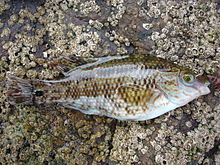- Corkwing wrasse
-
Corkwing wrasse 
Conservation status Scientific classification Kingdom: Animalia Phylum: Chordata Order: Perciformes Suborder: Labroidei Family: Labridae Genus: Symphodus Species: S. melops Binomial name Symphodus melops
(Linnaeus, 1758)Synonyms - Crenilabrus gibbus (Gmelin, 1789)
- Crenilabrus melops (Linnaeus, 1758)
- Labrus cornubius Gmelin, 1789
- Labrus gibbosus Bonnaterre, 1788
- Labrus gibbus Gmelin, 1789
- Labrus goldsinny Bonnaterre, 1788
- Labrus melops Linnaeus, 1758
- Labrus rone Ascanius, 1772
- Labrus tesselatus Bloch, 1792
- Labrus venosus Gmelin, 1789
- Lutjanus melops (Linnaeus, 1758)
- Lutjanus norvegicus Bloch, 1797
The corkwing wrasse (Symphodus melops) is a coastal wrasse, a fish of European waters.
Description
Its body is deep and compressed sideways with a single, long dorsal fin. It is usually about 15 centimetres (5.9 in) long but has reached 25 centimetres (9.8 in).
It is highly variable in colour, depending on the environment and age thaga of the fish. Corkwing wrasse have a black spot in the middle of the tail stalk, and a comma shaped spot behind the eye. Females and juveniles tend to be brown or greenish-brown, while the male is typically more brightly coloured. Both sexes have lines on the head and gill covers which are brown and pale blue in the female, bright green or blue in the male.
Reproduction
Males build a ball-shaped nest of seaweed in rock crevices or, in sedimentary areas, amongst seaweed or seagrasses. the nest has an entrance hole which the male guards aggressively.
Links

This Labridae article is a stub. You can help Wikipedia by expanding it.

